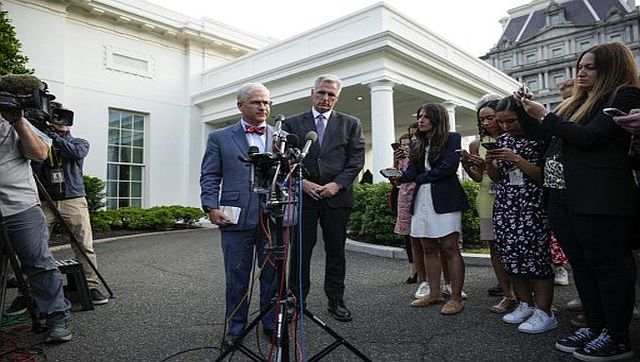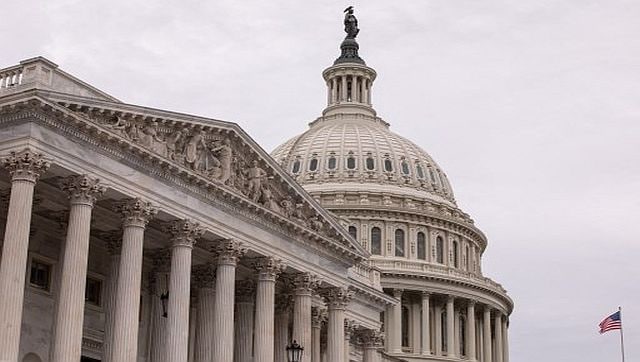There’s a nervous air in the United States as the deadline to increase the debt ceiling approaches. The United States faces the formidable challenge of averting a potential default and the stakes couldn’t be higher. In a race against time, President
Joe Biden
and House Republicans successfully concluded tense negotiations mere days before the looming threat of default. On Saturday, they reached a
crucial agreement
to raise the government’s debt ceiling, avoiding a
disastrous default.
Also Read: How a US debt default will affect everyday Americans
The deal however faces an unclear outlook in Congress, where progressive Democrats and hardline Republicans have both criticised components of the agreement. Here, are the key takeaways from the agreement, which still needs to be approved by a divided Congress in a vote on Wednesday. Did either side win? After days of long, difficult talks, the deal allows both sides to claim a victory of sorts. Biden called it a “compromise” while Republican House speaker Kevin McCarthy described it as “worthy of the American people.” The 99-page text was released Sunday night and the agreement will be subject to scrutiny and debate in the coming days. [caption id=“attachment_12659062” align=“alignnone” width=“640”] Representative Patrick McHenry and House Speaker Kevin McCarthy talk to reporters outside the West Wing after meeting with President Joe Biden in the Oval Office of the White House. AFP[/caption] Some demands from both camps were not accepted, such as the elimination of certain tax loopholes requested by Democrats, and the repeal of clean energy tax credits sought by Republicans. The crux of it Formally known as the Fiscal Responsibility Act of 2023, the bill provides for an increase to the debt ceiling of $31.4 trillion for two years, meaning Biden will crucially not need to negotiate it again before the November 2024 presidential election.
Also Read: US debt ceiling crisis: How this could create turmoil in the financial world
The deal also places limited curbs on federal spending that will please some Republicans, but it does not deliver the big cuts that right-wingers wanted and which progressive Democrats would have balked at. Spending The deal holds nonmilitary spending roughly flat for the 2024 fiscal year from this year. It also limits the increase by one per cent for 2025, according to the proposed bill.
Representative Patrick McHenry and House Speaker Kevin McCarthy talk to reporters outside the West Wing after meeting with President Joe Biden in the Oval Office of the White House. AFP[/caption] Some demands from both camps were not accepted, such as the elimination of certain tax loopholes requested by Democrats, and the repeal of clean energy tax credits sought by Republicans. The crux of it Formally known as the Fiscal Responsibility Act of 2023, the bill provides for an increase to the debt ceiling of $31.4 trillion for two years, meaning Biden will crucially not need to negotiate it again before the November 2024 presidential election.
Also Read: US debt ceiling crisis: How this could create turmoil in the financial world
The deal also places limited curbs on federal spending that will please some Republicans, but it does not deliver the big cuts that right-wingers wanted and which progressive Democrats would have balked at. Spending The deal holds nonmilitary spending roughly flat for the 2024 fiscal year from this year. It also limits the increase by one per cent for 2025, according to the proposed bill.
The agreement preserves plans by the Biden administration to increase spending for the military and veterans in line with inflation as well. IRS clawback The deal also pares back funds allocated for the expansion of the Internal Revenue Service (IRS). Last year, Congress approved $80 billion (Rs 6.60 lakh crore) for the IRS to boost tax enforcement. The debt ceiling agreement pulls back $10 billion to spend in other areas. [caption id=“attachment_12659082” align=“alignnone” width=“640”] The bill provides for an increase to the debt ceiling of $31.4 trillion (Rs 2.59 lakh crore) for two years. AFP[/caption] Unspent COVID money The deal would also take back some funding that Congress allocated for the coronavirus pandemic but did not spend. A statement from McCarthy’s office said the deal would rescind “billions in unspent COVID funds” but offered no further specificity. Also read: How past US debt ceiling crises affected the economy and politics
No changes will be made to Medicaid, the government’s health insurance program for the most disadvantaged Americans. Work requirements The deal establishes work requirements for people who are receiving federal food assistance or on family welfare, in a victory for the Republican side.
The bill provides for an increase to the debt ceiling of $31.4 trillion (Rs 2.59 lakh crore) for two years. AFP[/caption] Unspent COVID money The deal would also take back some funding that Congress allocated for the coronavirus pandemic but did not spend. A statement from McCarthy’s office said the deal would rescind “billions in unspent COVID funds” but offered no further specificity. Also read: How past US debt ceiling crises affected the economy and politics
No changes will be made to Medicaid, the government’s health insurance program for the most disadvantaged Americans. Work requirements The deal establishes work requirements for people who are receiving federal food assistance or on family welfare, in a victory for the Republican side.
It is set to raise the age at which childless adults will be required to work to receive food stamps from 49 to 54. As a concession to Democrats, the deal relaxes the requirements for veterans and the homeless. With inputs from AFP Read all the Latest News , Trending News , Cricket News , Bollywood News , India News and Entertainment News here. Follow us on Facebook , Twitter and Instagram .
)